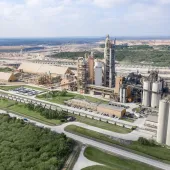A bit of a buzz at Aberthaw cement plant

Lafarge Tarmac enhance biodiversity programme with addition of five bee colonies
LAFARGE Tarmac’s Aberthaw cement plant has had a delivery of Apis mellifera – that’s honey bees for those not familiar with the world of bee-keeping.
Five new bee colonies at the plant are helping the local ecological cycle and also supporting local farmers by pollinating crops.
The cement plant has may areas close to the quarry that offer a lot of natural habitats, and facilitating biodiverse species on site is very important to Lafarge Tarmac.
Tasked with supporting these aims, environmental co-ordinator Kara Bennett has championed the addition of the new beehives to add to the site’s wildlife population.
She explained: ‘Our site is positioned between two river estuaries, the Thaw and the Kenson, and we have land near the quarry that we don’t use specifically and which naturally offers sites of biodiversity. The quarry is already home to wetland birds and some species of newts, with regular visits by flocks of Canada geese each year.
‘Part of my role is to make the most of what the plant naturally has to offer and the unique environment of the quarry. Setting aside space for our new bee colonies seemed a natural enhancement that would support our biodiversity programme.’
The beehives are being set up and will be looked after by a family of experienced bee-keepers – the Frasers – who will help workers at the site to learn more about the bees and how to care for them.
Lynda Fraser said: ‘As a family, we have been looking after bees for a number of years and we are delighted to be able to have more hives at the Aberthaw cement plant.
‘We have chosen a variety of bee that is known for its good temperament and also for its honey production. We are keen to promote sustainable honey collection, so never collect more honey from a hive than it can easily sustain.’









